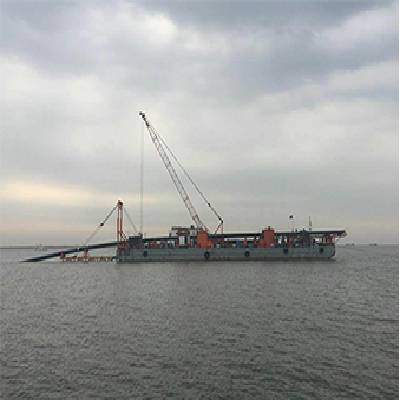Submarine cable is a cable wrapped with insulating material and laid on the bottom of the sea for telecommunication transmission. At present, more than 90% of the world's international data is transmitted through submarine optical cables. The history of submarine cable laying has been 160 years. The Submarine Pipeline Laying Company will tell you the history of Underwater Pipeline Laying and exploring the history of earth's submarine cable laying.
The first transoceanic cable was laid in 1854, connecting Newfoundland and Ireland, and it all benefited from the emergence of gutta gum because the metal wires wrapped in gutta gum can be laid on the seabed. The current flows freely in it, and it is not dissipated by seawater.
In 1854, British engineer Gisborne was responsible for laying the submarine cable from New York to Newfoundland. Technically, the Trans-Strait Cable is completely different from the Trans-Atlantic Cable. The laying of the English Channel cable can be completed in one day in calm and calm weather; with the sailing technology of the ship at that time, it took more than three weeks to cross the Atlantic Ocean, not counting the laying of machinery. The weight exceeded the load capacity of any ship at that time.
How to understand? At that time, the British government provided Field with one of the Royal Navy ’s largest battleships, the “Agamemnon”, while the US government provided a battleship with a displacement of 5,000 tons, the “Niagara”. Only half of the transoceanic cables were installed.

In August 1857, Field led the laying fleet from Ireland, accompanied by industry experts such as Morse, in order to monitor the laying situation in real-time, and one attempt ended in failure. In June 1858, Field led the fleet to go out again, and the second attempt failed again. In July of the same year, the Field Fleet set off again, "Agamemnon" and "Niagara" successfully joined in the middle of the Atlantic Ocean, and began the laying of transoceanic cables. Half of the cables on the two ships were docked together, and then "Niagara" sailed to the United States, and "Agamemnon" sailed to the United Kingdom. On August 5, "Niagara" reached the coast of Newfoundland, and "Agamemnon" arrived on the Irish coast on the same day. This great cause was finally completed.
China Submarine Cable Laying was also fruitful, dating back to the Qing Dynasty. In 1886, Taiwan ’s first governor, Liu Mingchuan, laid a waterway wire connecting Taiwan ’s entire island and the mainland, mainly for sending telegrams. By 1888, a total of two water lines had been erected: one was the 177-nautical-mile water line between Chuanshi Island in Fuzhou and Huawei (Freshwater) in Taiwan. It was mainly provided for the Taiwanese government to inform the Qing Dynasty of Taiwan ’s natural disasters, public security, finance, and Used for business communications; the other is the 53 nautical mile waterline that leads to Anping from Tainan to Penghu.
In 969, the Ministry of Posts and Telecommunications wanted to carry out military communications by transmitting optical signals through the atmosphere. The Wuhan Institute of Posts and Telecommunications of the Ministry of Posts and Telecommunications accepted the task and began research on optical fibre communication. At that time, optical fibre communication technology was just starting in developed countries in Europe and America. Because Wuhan Institute of Posts and Telecommunications has adopted the correct technical route of quartz optical fibre, semiconductor laser and coding system communicator, China has taken a lot of detours in the development of optical fibre communication technology. During that relatively closed period, the development of optical fibres, from raw material purification, smelting lathes, and wire drawing machines, to optical fibre test instruments and splicing tools, required independent research and development.
In the first half of 1976, Zhao Zisen, a lecturer at Wuhan Institute of Posts and Telecommunications, and his colleagues produced China's first 200-meter optical fibre sample; in 1979, he and his colleagues successfully produced China's first practical optical fibre, with a loss per kilometre of 4 decibels. In September of the same year, a 3.3 km 120-channel optical cable communication the system was completed in Beijing; in January 1982, the "Eight-Two Project" of the Ministry of Posts and Telecommunications opened China's first 8M / s practical local telephone optical fibre project in Wuhan. Communication has entered a practical stage. By the mid-1980s, China's optical fibre communication rate has reached 144Mb / s, which can transmit 1980 telephones, surpassing the coaxial cable carrier.
From 1989 to the end of 1998, China has participated in the construction and investment of 18 international submarine cables: in December 1993, the China-Japan (CJ) submarine cable system was completed with a total length of 1252 kilometres and total communication capacity of 7560 Telephone circuit; In February 1996, the China-Korea submarine cable was completed and opened, with a total length of 549 kilometres; the Sino-US submarine cable system with a total length of about 30,000 kilometres; the Asia-Europe submarine cable refers to the SEA-ME-WE3 system, with a total length of about 40,000 kilometres Connecting 33 countries and regions, etc., can be described as fruitful.
Note: If you found anything violating your copyright, please contact us, we would remove them as soon as possible.




